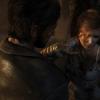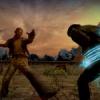Crystal Dynamics made the right decision to reboot the Tomb Raider series. Instead of churning out more of the same, they decided to roll the dice. Lara wasn’t relatable and the gameplay had stagnated. Their aim is to tell the untold story of Croft’s origins: How she became a tomb raider, where it all started, and why she’s such a cold blooded murderer.
For the most part, Crystal Dynamics excel in showing the industry that this is how reboots should be handle;, albeit with a few nonsensical hiccups along the way.
Tomb Raider follows the story of ABC’s TV Show LOST. Jack, Kate, and Sawyer (played by Lara Croft) are on a plane (played by a boat) and a storm forces them to crash onto an island seeped in mystery and intrigue.
Despite borrowing ideas from the hit TV show (including Dharma station[s]) the story of Tomb Raider and Croft’s origin is compelling from start to finish, even when it’s being outright silly, you’ll be itching to experience what happens next.
Certain lines like “When all seemed lost I found a truth,” and “Sacrifice is a choice you make, loss is a choice made for you,” help raise the story to levels exclusively occupied by BioWare titles. When a character speaks, the player is hanging off their every word.
The near-flawless writing is complemented by an equally stellar performance by Camilla Luddington (Grey’s Anatomy, True Blood). Luddington brings depth to Croft. As she shivers and tumbles her way through the world, Luddington reflects it effortlessly. When Croft is falling to pieces, as is Luddington. At no point does the player see Croft as a sprite in a videogame. She is a living, breathing person going through hell, thanks to Camilla Luddington.
One scene in particular shows how Crystal Dynamics are pushing the boat out (pun intended) when it comes to conveying a powerful, and more impactful story. During the first scenes, we see Lara Croft’s reflection in a mirror. Staring back at her is a young, innocent and beautiful girl. Later in the game, she looks into the same mirror, only this time starring back at her is someone else. This Lara is dirty, scarred, and emotionally drained. This Lara is a survivor.
My biggest gripe with the story is that for everything it does right, there are times of utter stupidity, and I can’t work out whose fault this is.
Tomb Raider came under fire last year for a scene that suggested rape. A man pins Lara up against a wall, and touches her inappropriately. Without context, this scene was instantly labelled ‘vile’ and ‘controversial’. People (read: trolls and journalists) who find talking about rape uncomfortable, would rather brush it under the rug than face up to the reality. It was easier to attack Tomb Raider as being ‘vile’ and ‘controversial’ than discuss an important and growing problem.
The scene itself isn’t controversial. On an island full of murderous men and no women, it fits. Context is everything, and with context, the scene is non-offensive. Horrible, disturbing, and distressing, yes, but offensive? No.
This scene, is however, ruined by a quick-time-event. To prevent Croft from getting raped, players must press a button at the right time. This is the story of Croft’s first kill, the first time she takes a life. When she is backed into a corner, when rape and death are starring her in the face, she makes the decision to survive. This moment changed her at the core. In this moment, Lara’s innocence is lost. Press Triangle to lose Lara’s innocence.
Are you fucking kidding me? This scene was destined to be etched into the history of gaming: “Our Princess is in another castle,” the moment you meet that first zombie in Resident Evil, the final level in Halo 3, and Lara’s first kill when she pressed Triangle at exactly the right time. I am offended that the solution to a controversial scene is to add a QTE to it to detract from the horrific nature of what’s going on.
This one scene, that could have been truly intense and moving, is nothing more than another QTE.
What’s more perplexing is that after Croft makes her first kill, killing instantly becomes second nature. Armed with a pistol and bow, Croft kills countless enemies mere moments after she first spilled blood. What’s the message? That once you’ve killed, it’s easy to then kill repeatedly? Croft was nearly sick when she first killed, but after a few minutes she’s okay with it and using her pickaxe to slit the throats of downed villains?
It’s a bit much.
This problem is further exasperated by ignoring player skill. How many first-person shooters have gamers nowadays played? Enough, you might say. So if you give a player a handgun, that handles well, they’re going to headshot every enemy they come across.
To summarize: Lara goes from killing for the first time via a QTE, to head-shotting everyone is slight within minutes. It’s a jump in character that doesn’t make sense. By the latter half of the game, it does. Lara has had enough and is determined to save her friends at any cost. She has purpose and a goal, and over time, has learned how to handle the weapons efficiently. Jumping from scared to merciless killer so fast, just doesn’t work.
There’s another issue that plagues the first half of the story. Someone decided they wanted to hurt Lara as much as humanly possible. Almost to the point of it being a kink.
Everything Lara does, goes wrong, and ends up hurting her. At first it’s to help the player want to ‘protect her’ and gain vengeance for the ordeal she has gone through, but after a few hours of Lara getting hurt, it becomes nothing more than an unfunny sketch from Monty Python‘s Flying Circus.
A few examples of this are: Lara falls, but falling isn’t enough, so she lands on a spike. Lara must enter through an enclosed space, with pipes either side of her. Lara’s bad day means one of the pipes happens to burst at the exact point she decides to pass them, resulting in her getting burnt. Lara climbs a ladder, ladder breaks. Lara reaches top of said ladder, birds fly out causing her to nearly lose her grip. Lara is saved. No wait. She’s not. Lara investigates. Falls to her death, survives somehow, grabs a parachute. First parachute doesn’t work…
It’s all too conveniently set up. Everything she touches turns to shit. I ‘get’ she must overcome adversity, but how much adversity is too much? Surely there comes a point where the game desensitises us and when something bad happens, we react with ‘Meh. Lara’s having a bad day again.’
It’s a crying shame that some of the best voice acting and writing this generation has seen is marred by such obviously bad design choices.
These issues are mostly rectified by the halfway point. QTEs become sparse and Lara can go more than five minutes without falling over, allowing us to really get inside her head and start to empathize.
What’s interesting is the latter half of the game more than makes up for the shortcomings of the first – you’ll finish Tomb Raider feeling satisfied. The story is tighter and it’s easy to lose yourself in the hard-hitting gameplay.
Tomb Raider features some of the most exciting shooting mechanics this side of Gears of War. The bow in particular is such a joy to use that you may end up using it exclusively. Running into a group of enemies is sure to result in death, so it’s up to the player to find the best way to dispatch them. This could mean sectioning them off and shooting them in the back of the head with your bow or firing an arrow into a lantern to cause a fire or explosion. It’s up to the player how they want to handle fights.
When you’re not trading bullets or arrows with enemies, you’ll be exploring. Tomb Raider is a linear game but you never feel like you’re tethered to a specific route or tied to what the game wants you to do. It’s here that it creates a real sense of a size that is begging to be explored. Hidden away in caves are tombs ready to be raided: short puzzle sections that give you something else to do should you need a break from the story.
Every aspect of the game’s world has been crafted to look gorgeous. The way fire creates a back draft when it hits ceilings, or the way Lara shivers at night, or if you’re on PC, her hair via the TressFX feature, everything looks stunning to the point where it’s easy to forget this is a game at the end of the current generation’s life-cycle.
Tomb Raider narrowly avoids a death sentence. On one hand, there are faults that make it laughable – and not in the way fighting a T-Rex is. On the other, it makes up for its faults and leaves the player feeling immensely satisfied and like they’ve experienced something brilliant.
As the credits rolled, my thoughts were of anger: “Why did it have to end? I want more!” Even for all its faults, Tomb Raider is a game worth playing. It somehow manages to fix itself the more you play, which is both marvellous and baffling.
Is Tomb Raider worthy of your consideration? I’d have to say, yes. Definitely.
[Editor's Note: Tomb Raider was originally released last year on PC, Xbox 360 and PS3. It has recently been re-released on Xbox One and PS4 with upgraded graphics and including DLC previously sold separately. The differences are minor enough that this review can be considered to cover all versions]









One comment